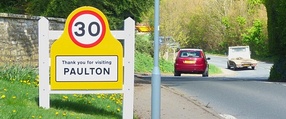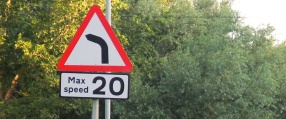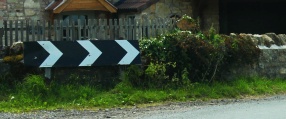Road markings
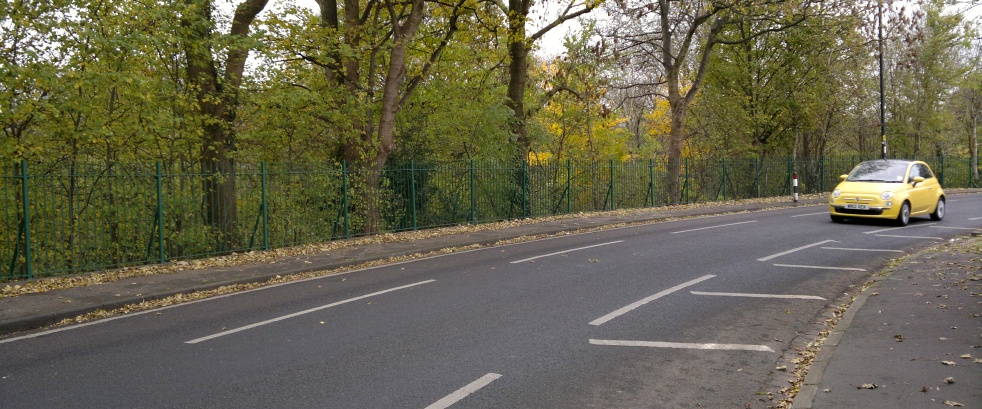
Road markings are painted on the road to mark out lanes for vehicles or to provide information to drivers. They are normally white in colour.
This page will consider the following road markings:
- Centre lines
- SLOW markings
- Speed limit roundels
- Peripheral hatching
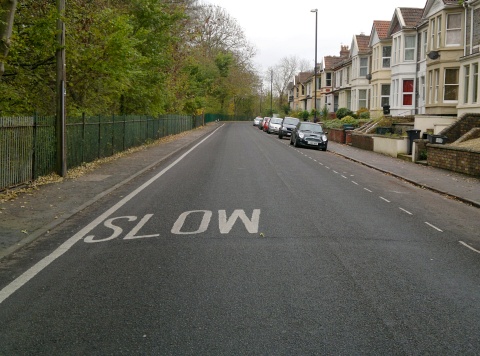
Disadvantages
- Road markings can be easily ignored
- Road markings need to be refreshed when they wear away (this depends on the amount of traffic, and the type of road surface)
- Road markings which are not regularly maintained (and are heavily worn) will not be effective
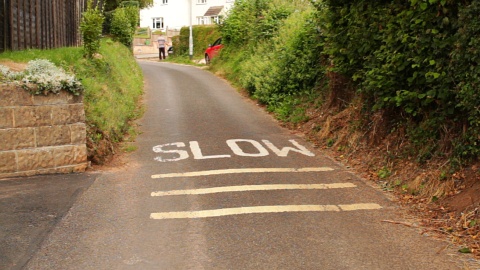
Restrictions
- On rural roads below 5.5 metre width, centre lines should be omitted
- Peripheral hatching can only be used on relatively wide roads (e.g. 12 metres)
- Centre line removal should not happen near one-way streets
- SLOW markings should be used in conjunction with hazard warning signs
- The Council is not permitted to place 30mph Speed limit roundels in an area with street lighting
There's also some general restrictions to note for all schemes
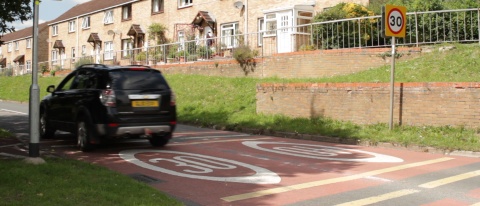
Advantages
- Road markings do not introduce discomfort to motor vehicle drivers or bus users
- Relatively cheap
- Do not reduce accessibility for large vehicles or emergency vehicles
Peripheral Hatching
Peripheral hatching is a method of reducing the width of the lane for motor vehicles by adding an additional line inwards from the kerb, so both lanes of traffic are moved towards the centre of the road. The space between the line and the kerb can be hatched with white lines.
Effectiveness
Peripheral hatching reduces vehicle speeds by around four percentage points. If a vehicle is travelling at 30 miles an hour, peripheral hatching would normally reduce speeds by at least 1.2 mph.
How it works
Reducing the width of lanes for motor vehicles reduces the feeling of space in the road. This causes drivers to reduce their speed, so they can ensure they are not overrunning the hatched area.
Removing the centre line
Removing the centre line can be easily achieved when a road is re-surfaced, and the centre line is simply not replaced. Centre lines are not usually removed from faster strategic routes.
Effectiveness
In a town or city environment with a 30 mph (or lower) speed limit, removing the centre line reduces speeds considerably, typically by around 5 to 9 mph - this is backed up by good quality research.
In a village environment with a 30 mph speed limit, it is likely that removing the centre line will improve safety, however the research here is lower quality.
For cyclists, removing the centre line in a 30 mph speed limit increases their comfort because vehicle drivers pass with more space. In a 20 mph limit, however, there is little difference.
How it works
Removing the centre line eradicates vehicle driver’s feelings of ‘designated space’ for them to drive in. They may expect other road users to enter their path, or make an unexpected manoeuvre. This is more likely to cause motor vehicle drivers to slow down as a safety precaution.
SLOW markings
SLOW markings simply state the word 'SLOW' in a road, painted in large letters.
Effectiveness
Research shows that SLOW markings have little impact on vehicle speeds - it appears that they are often ignored by vehicle drivers. They will be even less effective if they are overused, or used where they are unnecessary.
When used with warning signs
In conjunction with warning signs SLOW markings may be more effective, as drivers are informed why slowing down is necessary. Normally, Somerset County Council will only consider a new SLOW marking where a warning sign is present.
Speed limit roundels
Speed limit roundels show the current speed limit, painted on the road inside a circle. They are often used at the start of a new speed limit, or near speed limit reminder signs.
Effectiveness
Reminding drivers of the speed limit with roundels can be useful, especially because they may be more visible than ordinary speed limit signs. There is no effectiveness research available for roundels.
Advanced information
Peripheral Hatching
Speed when passing through peripheral hatching is based on a good quality simulator research study into speed reducing treatments (Jamson et al., 2010). The research specifically compared UK treatments on UK style roads. The research findings are considered to be very conservative, as the study only recruited young (19 to 25 years old) male drivers – younger drivers, and specifically young male drivers are most likely to be speeding, therefore research which is found to be effective on this group is thought to be at least equally effective on other motor vehicle users. A speed reduction of 4% may be greater across an average cross section of motor vehicle drivers.
Removing the Centre Line
In addition to the above, removing the centre could give a greater feeling of ‘shared space’, in which the road feels less like a facility for car drivers, but more for the benefit of all road users, including pedestrians and cyclists. In this case, motor vehicle drivers may be more willing to accommodate and respect other road users, and slow down for road users which are more vulnerable (.e.g pedestrians and cyclists).
The estimated reductions in motor vehicle speed are taken from Davis (2014), who carried out an evidence review on centre line removal. A trial from TfL in 2014 is the most rigorous study in this review, and used a good quality methodology.
"SLOW" markings
The statement that "SLOW" marking have little effect on vehicle speeds is based upon research from the U.S. Department of transportation. The study is somewhat weak due the research taking place at only two sites, however it is one of the few analyses into the effectiveness of the "SLOW" marking, so it is included.
References
Davis, A. (2014) A review of the evidence for effectiveness of centre-line removal to reduce vehicle speeds in signs-only 20mph and 30mph speed limits. Bristol City Council
Jamson, S., Lai, F., Jamson, H. (2010) Driving simulators for robust comparisons: A case study evaluating road safety engineering treatments. Accident Analysis and Prevention 42 pp. 961 - 971
Welch, T., Hallmark, S., Hawkins, N. (2009) Traffic Calming on Main Roads Through Rural Communities. U.S. Department of Transportation Federal Highway Administration. Iowa State University
